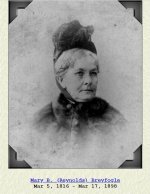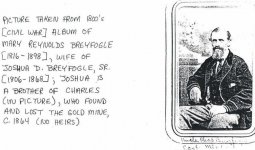Oroblanco
Gold Member
- Jan 21, 2005
- 7,838
- 9,827
- Detector(s) used
- Tesoro Lobo Supertraq, (95%) Garrett Scorpion (5%)
There are a number of different versions of the tale, basically a man named Breyfogle with several companions met an Indian at their camp at a spring; said Indian (a Paiute usually) led Breyfogle to the gold vein, in the meantime other Indians attacked his companions at the camp, and Breyfogle was whacked in the head with a tomahawk and left for dead. On coming to, he picked up samples of the gold ore, described as (fill in the blank here - many different descriptions) a rotten quartz, black quartz, chocolate brown quartz, rose quartz, pink quartz, green quartz, even white and yellow quartz. Breyfogle staggers back to the camp and finds his companions dead, hikes or wanders for days and is either found and brought to a ranch or wanders to the ranch on his own. Later Breyfogle launched a number of expeditions to find his mine again, wandering all over the Death Valley country from the El Paso mountains to Austin Nevada, without ever finding it again.
His story has been denounced as a fairy tale, a fiction made up to get investors to bankroll his searches (eg grubstaking) etc but it is a fact that there was such a man, and the ore specimens were in circulation for many years. I have not been able to find even one photo of this mysterious ore. Anyway it is also a fact that Breyfogle made repeated searches for the mine himself, which says something IMHO. He was willing to put his own boots on the ground, and had rich ore unlike the ore from known mines of the area.
Now it has been announced that the Breyfogle has been rediscovered, many times. One version states that a specimen of the Amargosa mine ore was compared to a piece of Breyfogle's ore, and it was a perfect match. Unfortunately we don't know if that was actually a piece of Breyfogle ore, and the Amargose ore was a pretty rose quartz. Others claimed that the green quartz of the Bullfrog mine was an exact match for the Breyfogle, and again the Johnnie mine ore was an exact match - and certainly, not all of these can be right.
So here is my question, which is basically this - how many of you are actively searching for the Breyfogle mine? Thanks in advance, really just curious as this was at one time one of the most famous and most searched-for lost mines in the USA.
Good luck and good hunting amigos y amigas, I hope you find the treasures that you seek.
Oroblanco
Sock coffee anyone?





His story has been denounced as a fairy tale, a fiction made up to get investors to bankroll his searches (eg grubstaking) etc but it is a fact that there was such a man, and the ore specimens were in circulation for many years. I have not been able to find even one photo of this mysterious ore. Anyway it is also a fact that Breyfogle made repeated searches for the mine himself, which says something IMHO. He was willing to put his own boots on the ground, and had rich ore unlike the ore from known mines of the area.
Now it has been announced that the Breyfogle has been rediscovered, many times. One version states that a specimen of the Amargosa mine ore was compared to a piece of Breyfogle's ore, and it was a perfect match. Unfortunately we don't know if that was actually a piece of Breyfogle ore, and the Amargose ore was a pretty rose quartz. Others claimed that the green quartz of the Bullfrog mine was an exact match for the Breyfogle, and again the Johnnie mine ore was an exact match - and certainly, not all of these can be right.
So here is my question, which is basically this - how many of you are actively searching for the Breyfogle mine? Thanks in advance, really just curious as this was at one time one of the most famous and most searched-for lost mines in the USA.
Good luck and good hunting amigos y amigas, I hope you find the treasures that you seek.
Oroblanco
Sock coffee anyone?









 ? Good luck and good hunting amigos, I hope you find the treasures that you seek.
? Good luck and good hunting amigos, I hope you find the treasures that you seek. Though I have no idea as to where it occurred...I know it has something to do with a new assayer in town who was giving people higher assay reports compared to other assayers in the town...And some guy thought that he'd pull a fast one on the assayer...
Though I have no idea as to where it occurred...I know it has something to do with a new assayer in town who was giving people higher assay reports compared to other assayers in the town...And some guy thought that he'd pull a fast one on the assayer...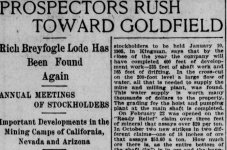

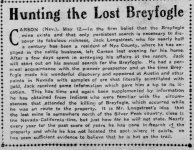
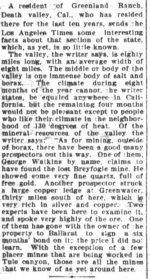

 But I’m always wandering, on-line, in the world...I found a thread on another site, not sure what the rules are for mentioning that site here...it prompted me to order an old George Thompson book that mentions Hurricane Cliffs. I’m not certain of many things, but I’m certain I found something. After nearly 20 years of exploring via google earth, I know my eyes do not deceive me. This is an unnatural anomaly that 6 years ago would have had me scratching my head.
But I’m always wandering, on-line, in the world...I found a thread on another site, not sure what the rules are for mentioning that site here...it prompted me to order an old George Thompson book that mentions Hurricane Cliffs. I’m not certain of many things, but I’m certain I found something. After nearly 20 years of exploring via google earth, I know my eyes do not deceive me. This is an unnatural anomaly that 6 years ago would have had me scratching my head.